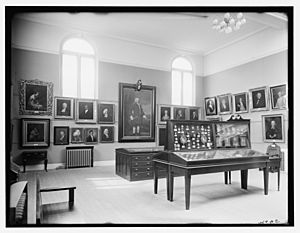Essex Institute facts for kids
The Essex Institute was a special place in Salem, Massachusetts, that collected and shared knowledge about history, science, and literature. It was open from 1848 to 1992. This institute had a museum, a large library, and even looked after old, important houses. It also offered many learning programs and published interesting books and papers.
In 1992, the Essex Institute joined with another museum, the Peabody Museum of Salem. Together, they became what is now known as the Peabody Essex Museum.
In 2017, the museum announced that many of its historical documents (about 42,000 feet of them!) were moved to a new location in Rowley, Massachusetts. This move allowed two old buildings, Plummer Hall and Daland House, which used to hold the library, to be repaired and made better.
History of the Essex Institute
The Essex Institute was created when two groups decided to join forces. These were the Essex Historical Society and the Essex County Natural History Society.
Daniel Appleton White, who was a judge, became the first president of the institute in 1848. He led the institute until he passed away in 1861. Around 1879, the institute kept its science collections in a building called East India Marine Hall. Its library was in Plummer Hall.
An old travel guide from 1880 said that the institute had many goals. One of its most important goals was to find and save everything related to the history of Essex County.
Learning and Fun Programs
Besides having a library and a museum, the institute also put on many educational programs. For example, in the 1880s, they offered:
- Lectures: They had many talks each winter on different topics. These included literature, history, languages, travel, and science. People also read papers at regular meetings.
- Music: There were regular music shows each season, plus other concerts.
- Art Shows: They held art exhibitions once or twice a year. These shows displayed paintings, statues, and crafts made by people from Essex County. They also had shows for plants and farming.
- Field Meetings: During the summer, they held several "field meetings" in different parts of the county. At these meetings, people gave talks about the history of the place they visited. They also talked about the plants and rocks found there. Often, famous scientists or historians would speak on a special topic.
By the 1930s, the institute owned two beautiful houses in Salem. These were the Peirce-Nichols House, built in 1782, and the Gardner-Pingree House, built in 1804. Both of these historic homes were open for people to visit.
Images for kids
See also
- Peabody Essex Museum, the museum that formed after the Essex Institute joined with another group in 1992.
- List of historical societies in Massachusetts






